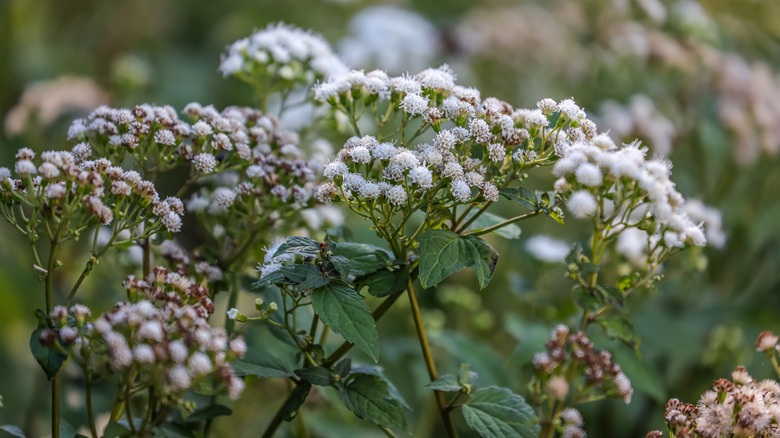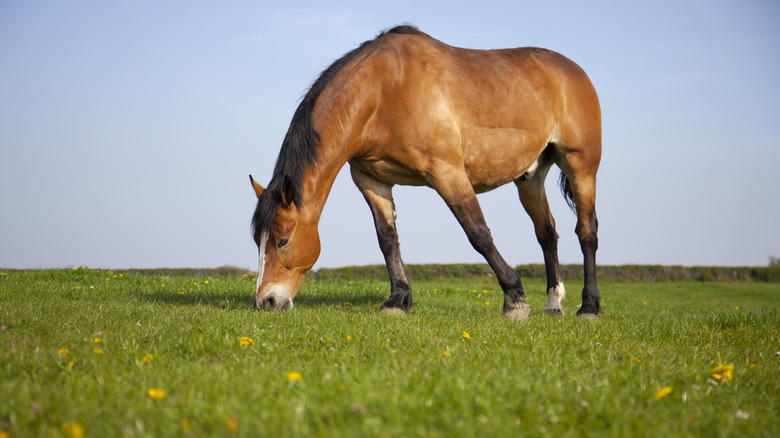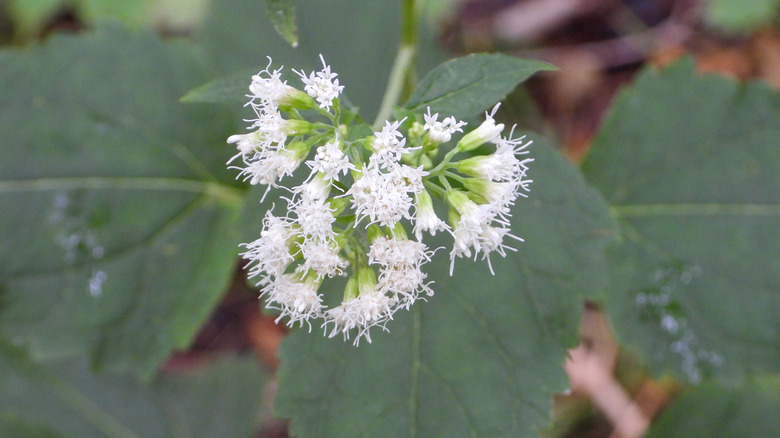Snakeroot Plants Might Keep Snakes Away, But There's A Double-Edged Sword To Them
Snakes can be risky garden visitors, especially if you have kids and pets roaming around the yard. However, deterring them with snakeroot plants might prove to be just as dangerous. Snakeroot, also called white snakeroot, comprises over 330 plants in its genus. It was previously thought that the plant could treat venomous snake bites, but that proved to be false. Unfortunately, the chemicals in the plant make it toxic to animals when eaten — it's not safe for people, but it's especially toxic for cattle, sheep, horses, dogs, cats, and guinea pigs. Snakeroot is one plant you should never grow in a home with pets for that reason. It contains the toxins tremetone, dehydrotremetone, and 2-oxyangeloyl-tremetone. It might keep snakes away, but snakeroot only poses problems of its own.
The plant's clusters of white flowers, with their tuft-like growth, give off an air of innocence and can easily be confused for baby's breath, but don't confuse this plant for its harmless look-alike. The cocktail of poisons produced by snakeroot is deadly. Because of the risks the plant poses, it's critical to understand what symptoms to look out for in your pets and livestock in the event that they've consumed the plant. Additionally, it's important to be able to identify the plant so you can take the necessary precautions to remove it from your yard and garden or limit animal access to it.
Signs your animals ingested the poisonous snakeroot plant
There is a lack of scientific consensus surrounding the actual dangers snakeroot poses. Given the laundry list of clinical symptoms produced from animals eating snakeroot, it's best to err on the side of caution if you have a furry companion. In livestock and grazing animals, snakeroot plant ingestion can cause skeletal muscle necrosis. Tremors can be another indication that your animal ate the plant. Other clinical signs of poisoning from the plant can include weight loss, constipation, shortness of breath, salivation, acetone odor to the breath and urine, and heart trouble.
Symptoms from eating the plant can show up within a few days to weeks after consuming snakeroot. Suckling animals, while less at risk, can still be susceptible to intoxication if they drink contaminated milk from their mother. Data is not sufficient enough to prove exactly how much of the plant needs to be consumed to be toxic, especially in specific groups of animals, but field observations of horses, cattle, and sheep estimate that number could be in the range of 0.5% to 2% of bodyweight when the plant was consumed over a period of one to three weeks. In your small animal friends, like cats and dogs, any amount could be dangerous. A vet should be contacted immediately if you suspect they've ingested any part of a snakeroot plant.
How to identify snakeroot plants and remove them from your yard
It goes without saying that preventative measures in the case of snakeroot ingestion are life-saving for your animal. First, familiarize yourself with the plant. Since the flowers come out in the fall, this is also when the plant is the most easy to identify. It grows as a perennial and has multiple branches of white, fuzzy flowers. Snakeroot is hardy in USDA zones 3 to 8 — that's nearly all of the continental U.S. except for the northernmost and southernmost bands of the country. It grows from 1 to 4 feet tall and has leaves with pointed edges. Oddly enough, while the plant is detrimental to many mammals, it's a prized pollinator-friendly flower.
You might notice it typically growing in shaded areas. Grazing animals may come into contact with the plant while out at pasture, but snakeroot can also be found in wooded areas or thickets. Limit animal access to the plant by fencing off wooded areas. Don't allow animals to pasture where snakeroot has been found. To manage the plant's growth, you can mow it down or apply herbicides to the plant. To remove it completely, put on a pair of gloves and pull the snakeroot out from the soil. You can uproot the plant the easiest after a hard rain when the ground is soft. Burn the plant after you've pulled it to ensure it doesn't come into contact with any other garden material or vulnerable animals.


